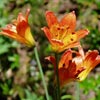|
HOME ABOUT LISA BERRY CONTACT INFO GIFT IDEAS LINKS REVIEWS REFERENCES Alpine Buttercup Alpine Gold Alpine Heather Alpine Lily Brown's or Wild Peony Camas Lily Corn Lily Crimson Columbine Elephant Heads Great Red Paintbrush Green Gentian Large-Leaf Lupine Little Elephant's Head Mariposa Lily Monkshood Mountain Bluebells Mountain Jewelflower Prairie Smoke Ranger Buttons Red Mountain Heather Rock Fringe Rosy Sedum Showy Penstemon Sierra Gooseberry Sierra Primrose Sierra Shooting Star Sierra Wallflower Snowplant Steer's Head Swamp Onion Towering Larkspur |
THE APPEAL OF WILDFLOWERSWhat is it about wildflowers that makes people want to walk among them? Is it the diversity of color? the aroma in the fresh air? Why do we get so much joy from gazing upon wild gardens? Natural color exploding on a landscape delights us, perhaps because the color doesn't come from a paint can, toxic dye, or trick lighting. It's the real thing, and it is serving a specific function. The purpose of color is to attract, or in some cases repel certain pollinators, so flowers evolve into the colors that best ensure their propagation. A flower's color, along with structure and size, determine who will drop by for a visit. Lupine, larkspur, mints, and penstemon entice bees and bumblebees. Some flowers charm butterflies and moths while others, like crimson columbine and the scarlet fritillary attract the company of hummingbirds. Natural color exploding on a landscape delights us, perhaps because the color doesn't come from a paint can, toxic dye, or trick lighting. It's the real thing, and it is serving a specific function. The purpose of color is to attract, or in some cases repel certain pollinators, so flowers evolve into the colors that best ensure their propagation. A flower's color, along with structure and size, determine who will drop by for a visit. Lupine, larkspur, mints, and penstemon entice bees and bumblebees. Some flowers charm butterflies and moths while others, like crimson columbine and the scarlet fritillary attract the company of hummingbirds.So, humans are far from alone in their attraction to flowers. Indeed, when we stumble upon a wild garden, we're also stumbling upon a thriving social scene, a mixer, a merry bacchanalia where everyone is mingling, interacting, and saying hello. The more one expands his or her wildflower experience, the more intriguing and enigmatic wildflowers become. While we most often see them as beautiful and aromatic, flowers can also appear strange like the wild peony, with green pods growing out of its tendrilly yellow center. Flowers like elk thistle are scary-looking with spiky, hairy, menacing leaves that warn us not to touch. Some wildflowers have disagreeable or peculiar odors. Bistort, for example, is also known as "dirty socks" and has been described as "smelling like decaying flesh." Spotted mountain bells, are well-camouflaged and elusive, hiding in the shadows of shrubs or small boulders. Many flowers, like ranger buttons, steer's head, and prairie smoke look just like their names. Elephant heads look like tiny elephant heads stacked on top of each other. Shooting stars, with their reflexed petals appear ready for blast-off. And let's not forget what flowers do for us and the planet. It is through flowering that plants reproduce themselves, and it is through plants that we get oxygen, food, and even medicine. Camas lily bulbs were a major food source for the Nez Perce who, for community festivals, molded them into cookies that tasted like brown sugar. Early American settlers used the checkermallow (or white-veined mallow) to treat insect stings and extract thorns and splinters. Historically, wildflowers treated a very diverse range of ailments including gall bladder problems, rheumatism, infection, colic, dermatitis, toothaches, headaches, gas, and depression. Wildflowers were also used to construct a variety of useful items, including fishing nets, snowshoes, glue, dye, hair oil, and diapers. So next time you decide to get out and see what flowers Mother Nature is featuring, remember how much wildflowers offer us besides their color. For an optimum wildflower viewing experience: Slow down, and don't be afraid to take a closer look. Ventures into wild gardens promise an inspiring view of our beloved, natural treasures. |
